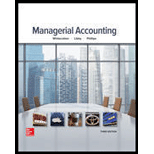
Identify and briefly describe the assumptions of CVP.
Introduction:
Cost-volume profit analysis is a tool that helps in decision making by establishing a relationship between volume, price, variable cost, fixed cost and profit.
To identify and describe:
The assumptions of CVP.
Answer to Problem 1Q
The assumptions of CVP are:
- Linear cost and revenue function
- Cost can be categorized as either fixed or variable
- Only volume affects total cost and total revenue.
- Volume of production is equals to volume of sales
- Product mix is constant
Explanation of Solution
The assumptions of CVP are:
Linear cost and revenue function:
A straight line is used to describe the relationship between total cost and sales volume and total revenue and sales volume.
Cost can be categorized as either fixed or variable:
To find mixed cost, we must determine total fixed cost and variable cost per unit.
Only volume affects total cost and total revenue:
Other factors such as employee learning curve, productivity gains etc. are ignored.
Volume of production is equals to volume of sales:
It is assumed that There will not be any change in beginning or ending inventory, it is assumed that all the units produced are sold during a period.
Product mix is constant:
The companies dealing in multiple products assumes that units sold, or sales revenue generated from each product or service line remains constant.
Want to see more full solutions like this?
Chapter 6 Solutions
Managerial Accounting
- A firm is considering making a change to its capital structure to reduce its cost of capital and increase firm value. Right now, it has a capital structure that consists of 20% debt and 80% equity, based on market value. The risk-free rate is 6% and the market risk premium is 5%. Currently the company's costs of equity, which is based on the CAP<, is 12.5% and its tax rate is 40%. What would be Carwright's estimated cost of equity if it were to change its capital structure to 60% debt and 40% equity?arrow_forwardA company has the following data, in thousands. Assuming a 365-day year, what is the firm's cash conversion cycle? Annual Sales = $45,000 Annual cost of goods sold = $31,500 Inventories = $4,250 Accounts receivable = $2,000 Accounts payable = $3,400arrow_forwardaccounting questionarrow_forward
 EBK CONTEMPORARY FINANCIAL MANAGEMENTFinanceISBN:9781337514835Author:MOYERPublisher:CENGAGE LEARNING - CONSIGNMENT
EBK CONTEMPORARY FINANCIAL MANAGEMENTFinanceISBN:9781337514835Author:MOYERPublisher:CENGAGE LEARNING - CONSIGNMENT Intermediate Financial Management (MindTap Course...FinanceISBN:9781337395083Author:Eugene F. Brigham, Phillip R. DavesPublisher:Cengage LearningPrinciples of Accounting Volume 2AccountingISBN:9781947172609Author:OpenStaxPublisher:OpenStax College
Intermediate Financial Management (MindTap Course...FinanceISBN:9781337395083Author:Eugene F. Brigham, Phillip R. DavesPublisher:Cengage LearningPrinciples of Accounting Volume 2AccountingISBN:9781947172609Author:OpenStaxPublisher:OpenStax College



